Serving 499 students in grades 6-8, Peter Muhlenberg Middle School ranks in the bottom 50% of all schools in Virginia for overall test scores (math proficiency is bottom 50%, and reading proficiency is bottom 50%).
The percentage of students achieving proficiency in math is 33% (which is lower than the Virginia state average of 54%). The percentage of students achieving proficiency in reading/language arts is 57% (which is lower than the Virginia state average of 69%).
The student:teacher ratio of 12:1 is lower than the Virginia state level of 14:1.
Minority enrollment is 29% of the student body (majority Hispanic), which is lower than the Virginia state average of 56% (majority Black).
Quick Stats (2025)
- Grades: 6-8
- Enrollment: 499 students
- Student:Teacher Ratio: 12:1
- Minority Enrollment: 29%
- Overall Testing Rank: Bottom 50% in VA
- Math Proficiency: 33% (Btm 50%)
- Reading Proficiency: 57% (Btm 50%)
- Science Proficiency: 40-44% (Btm 50%)
- Source: National Center for Education Statistics (NCES), VA Dept. of Education
Top Rankings
Peter Muhlenberg Middle School ranks among the top 20% of public schools in Virginia for:
Category
Attribute
Student Attention
School Overview
Peter Muhlenberg Middle School's student population of 499 students has declined by 13% over five school years.
The teacher population of 42 teachers has declined by 8% over five school years.
Grades Offered
Grades 6-8
(offers virtual instruction)
(offers virtual instruction)
Total Students
499 students
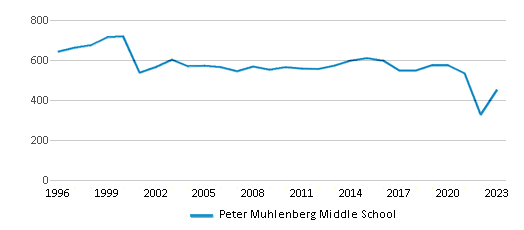
Gender %
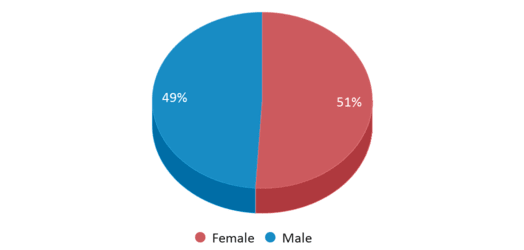
Total Classroom Teachers
42 teachers

Students by Grade
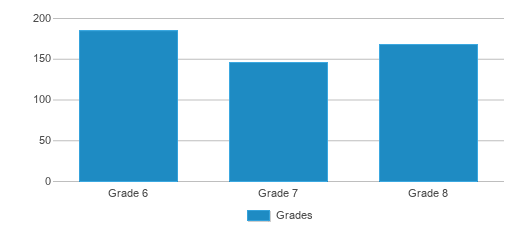
School Rankings
Peter Muhlenberg Middle School ranks within the bottom 50% of all 1,792 schools in Virginia (based off of combined math and reading proficiency testing data).
The diversity score of Peter Muhlenberg Middle School is 0.46, which is less than the diversity score at state average of 0.72. The school's diversity has stayed relatively flat over five school years.
Overall Testing Rank
#1427 out of 1792 schools
(Bottom 50%)
(Bottom 50%)

Math Test Scores (% Proficient)
(20-21)33%
54%
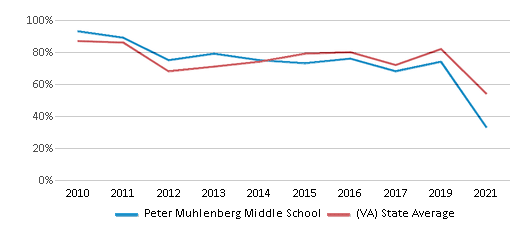
Reading/Language Arts Test Scores (% Proficient)
(20-21)57%
69%
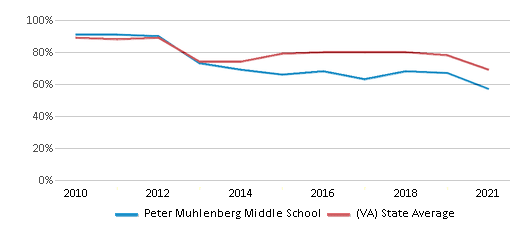
Science Test Scores (% Proficient)
(20-21)40-44%
59%
Student : Teacher Ratio
12:1
14:1

American Indian
1%
n/a
Asian
n/a
8%
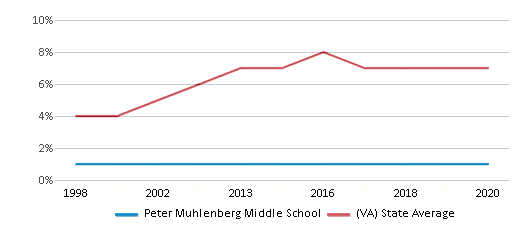
Hispanic
20%
19%
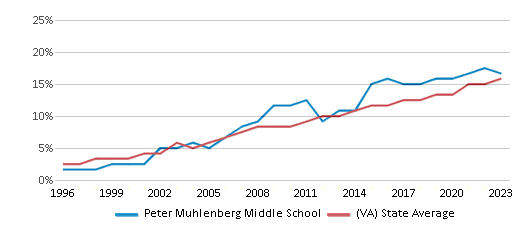
Black
4%
22%
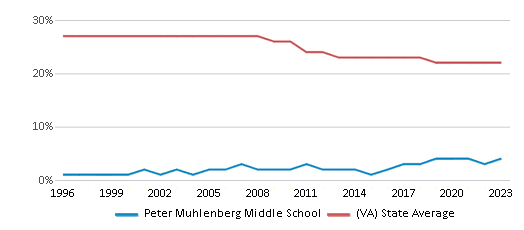
White
71%
44%
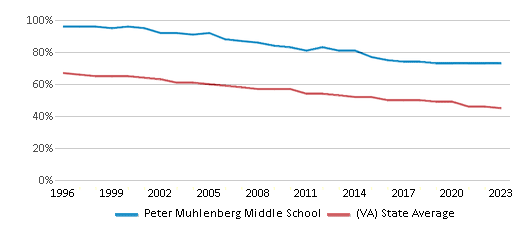
Hawaiian
n/a
n/a
Two or more races
4%
7%
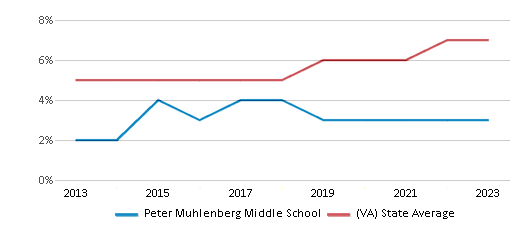
All Ethnic Groups
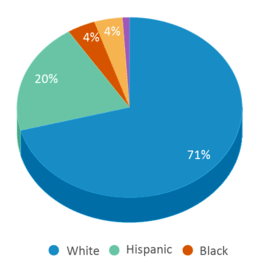
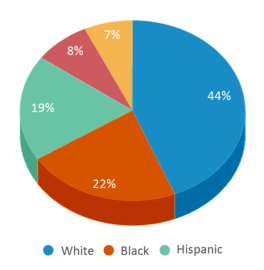
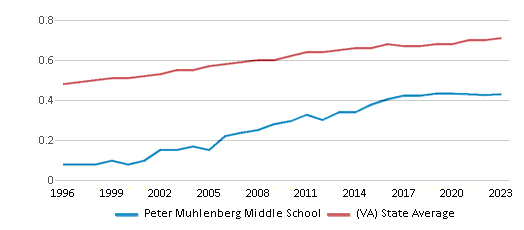
Eligible for Free Lunch
79%
55%
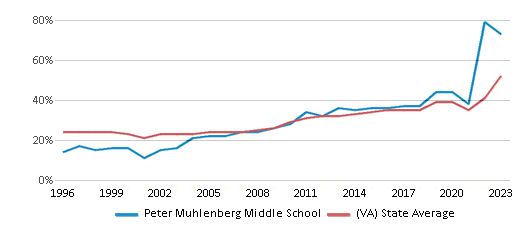
Eligible for Reduced Lunch (21-22)
9%
5%
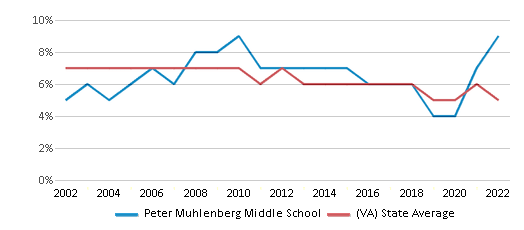
School Statewide Testing
School District Name
Source: National Center for Education Statistics (NCES), VA Dept. of Education
Profile last updated: 02/09/2025
Frequently Asked Questions
What is Peter Muhlenberg Middle School's ranking?
Peter Muhlenberg Middle School is ranked #1427 out of 1,792 schools, which ranks it among the bottom 50% of public schools in Virginia.
What schools are Peter Muhlenberg Middle School often compared to?
Peter Muhlenberg Middle Schoolis often viewed alongside schools like Signal Knob Middle School, Central High School, W.w. Robinson Elementary School by visitors of our site.
What percent of students have achieved state testing proficiency in math and reading?
33% of students have achieved math proficiency (compared to the 54% VA state average), while 57% of students have achieved reading proficiency (compared to the 69% VA state average).
How many students attend Peter Muhlenberg Middle School?
499 students attend Peter Muhlenberg Middle School.
What is the racial composition of the student body?
71% of Peter Muhlenberg Middle School students are White, 20% of students are Hispanic, 4% of students are Black, 4% of students are Two or more races, and 1% of students are American Indian.
What is the student:teacher ratio of Peter Muhlenberg Middle School?
Peter Muhlenberg Middle School has a student ration of 12:1, which is lower than the Virginia state average of 14:1.
What grades does Peter Muhlenberg Middle School offer ?
Peter Muhlenberg Middle School offers enrollment in grades 6-8 (offers virtual instruction).
What school district is Peter Muhlenberg Middle School part of?
Peter Muhlenberg Middle School is part of Shenandoah County School District.
School Reviews
1 3/16/2020
I am an eighth grade hers and I've been just about everywhere in the school and have suffered through three years of weird puberty stuff and the workload plus trying to figure out who I am plus battling depression has been really stressed full. The school also does nothing about the bullying from what I've seen and in half the classes I have I don't really absorb the information they're teaching me. Also, the dress code just doesn't make sense half the time. Some people get in trouble for showing belly while others don't and I've heard about people getting dress coded about ripped jeans. Overall, this school could be better with some improvements such as a more interactive learning plan giving out the right punishment to students and teaching the children here to be more accepting so as to stop the bullying.
5 3/9/2009
Fabulous! There's an anti-bullying student organization, teachers who are willing to help you, and all sorts of extra-curricular activities.
Review Peter Muhlenberg Middle School. Reviews should be a few sentences in length. Please include any comments on:
- Quality of academic programs, teachers, and facilities
- Availability of music, art, sports and other extracurricular activities
Recent Articles

What Is A Charter School?
Explore the world of charter schools in this comprehensive guide. Learn about their history, how they operate, and the pros and cons of this educational innovation. Discover key facts about charter schools, including admission policies, demographics, and funding, as well as what to look for when considering a charter school for your child.

10 Reasons Why High School Sports Benefit Students
Discover the 10 compelling reasons why high school sports are beneficial for students. This comprehensive article explores how athletics enhance academic performance, foster personal growth, and develop crucial life skills. From improved fitness and time management to leadership development and community representation, learn why participating in high school sports can be a game-changer for students' overall success and well-being.

February 05, 2025
Understanding the U.S. Department of Education: Structure, Impact, and EvolutionWe explore how the Department of Education shapes American education, from its cabinet-level leadership to its impact on millions of students, written for general audiences seeking clarity on this vital institution.








